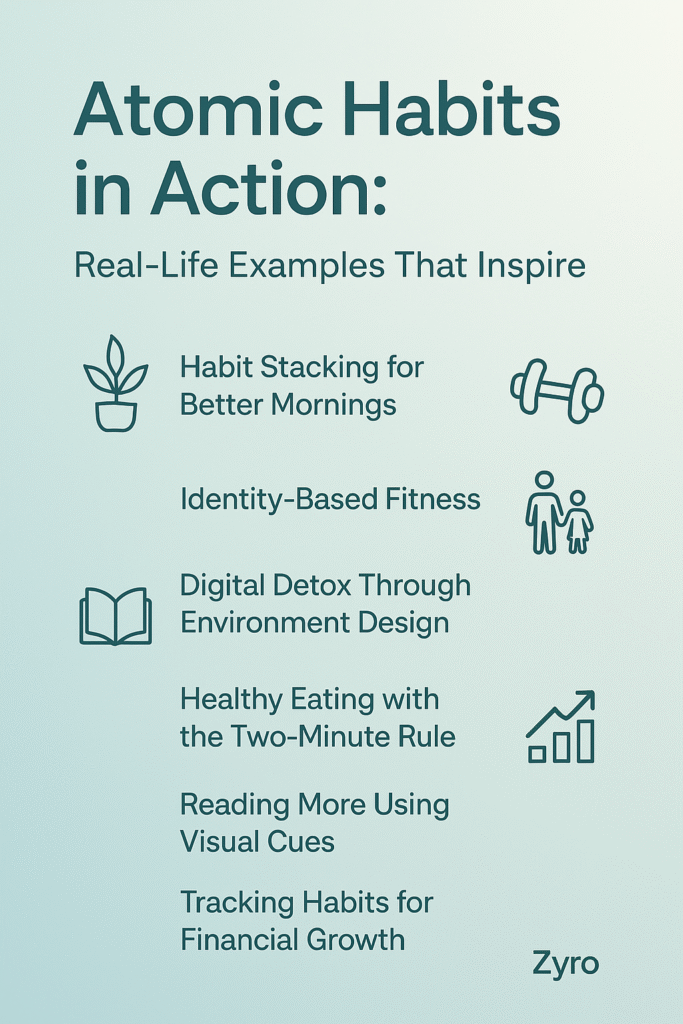Discover how real people are using the power of atomic habits to transform their lives. Get inspired by practical, proven examples that show how small changes lead to big results.
Introduction
James Clear’s bestselling book Atomic Habits revolutionized how we view personal development. The core idea? Small, consistent changes – atomic habits – can lead to massive, lasting results. While the theory is compelling, the true magic lies in real-world application. In this article, we explore inspiring real-life examples of atomic habits in action to show you how minor tweaks in daily routines can lead to powerful transformations.

1. Morning Routines that Stick: The Power of Habit Stacking
Real-Life Example: Sarah, a Busy Mom and Freelancer
Sarah struggled to find time for self-care amidst work and parenting. After reading Atomic Habits, she used the technique of habit stacking – attaching a new habit to an existing one.
Her Strategy:
After making coffee, she does a 5-minute guided meditation.
While brushing her teeth, she recites daily affirmations.
Results:
Within a month, Sarah noticed increased clarity, reduced stress, and a better start to her day – all from piggybacking new habits onto her existing ones.
Takeaway:
Linking new habits to ones you already do (like brushing your teeth or making tea) increases the chances they’ll stick.
2. Fitness through Identity-Based Habits
Real-Life Example: Mike, a Former Couch Potato
Mike always saw himself as someone who “hated exercise.” Instead of forcing intense gym routines, he embraced Clear’s concept of identity-based habits.
His New Identity:
“I am someone who moves daily.”
His Tiny Habit:
Start with just one push-up a day.
What Happened:
The simplicity helped him stay consistent. One push-up became ten, then twenty. Months later, he runs 5Ks weekly and even leads a local running group.
Takeaway:
To change your behavior, change your identity first. Focus on becoming the type of person you want to be, and let small habits reinforce that identity.
3. Digital Detox with Environmental Design
Real-Life Example: Priya, a College Student
Priya found herself endlessly scrolling through social media during study time. She implemented Clear’s environment design principle.
Her Changes:
Removed social apps from her phone.
Kept her phone in another room while studying.
Installed browser blockers on her laptop.
Impact:
Her screen time dropped by 40%, and her grades improved significantly.
Takeaway:
Make good habits easy and bad ones hard by changing your surroundings.
4. Healthy Eating Made Easy with the Two-Minute Rule
Real-Life Example: James, a Software Engineer
James wanted to eat healthier but often opted for fast food out of convenience. He applied the two-minute rule to meal prep.
His Approach:
Prepped fruit and veggie snacks that take under two minutes to eat.
Made smoothie packs in advance for quick blending.
Outcome:
He gradually replaced junk food with nutritious snacks and lost 15 pounds over six months.
Takeaway:
Make the first step of a good habit so easy it takes less than two minutes.
5. Reading More Through Visual Cues
Real-Life Example: Lina, a Marketing Manager
Lina wanted to read more but always forgot. Inspired by Atomic Habits, she used visual cues to trigger the behavior.
Her Method:
Placed her book on the pillow in the morning.
Left a reading list on her fridge.
Result:
She now reads one book a month and finds it easier to unwind at night.
Takeaway:
Our habits are often responses to cues in our environment. Use visual triggers to prompt positive behavior.
6. Financial Growth with Habit Tracking
Real-Life Example: Raj, an Aspiring Investor
Raj wanted to save more money. He started by tracking every expense in a notebook – a tiny habit that took under 5 minutes.
His System:
Tracked daily expenses.
Celebrated every no-spend day with a sticker on his calendar.
End Result:
Raj saved over $3,000 in a year and invested in his first stock portfolio.
Takeaway:
Tracking small wins builds momentum and turns good intentions into visible progress.
Conclusion: Start Small, Dream Big
The secret of Atomic Habits isn’t about making huge changes overnight. It’s about becoming 1% better every day. Whether it’s health, productivity, relationships, or finances, these real-life examples prove that small, consistent actions lead to remarkable outcomes.
Your Turn:
What’s one tiny habit you can start today? Whether it’s drinking a glass of water each morning or writing a single sentence in your journal, start small. Stick with it. Watch it grow.
Leave a Reply